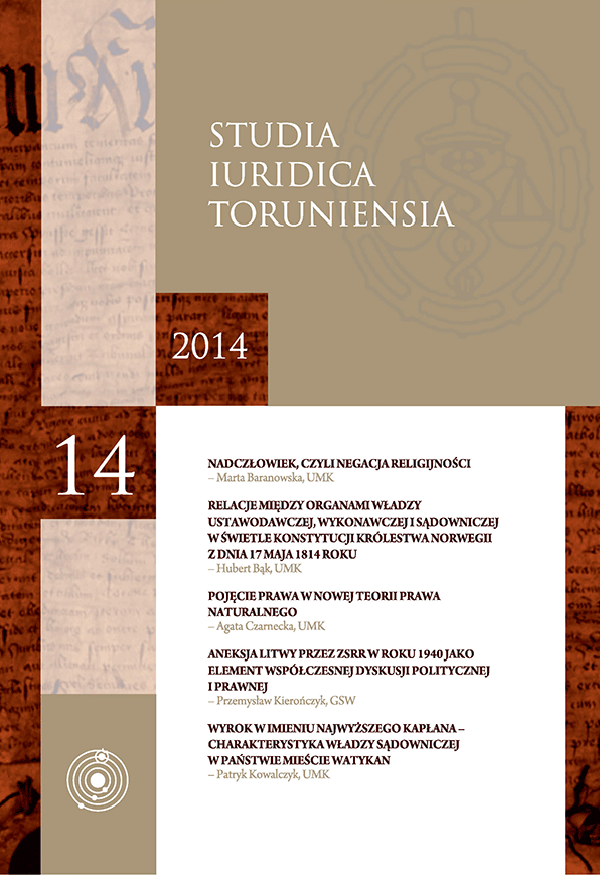The Republic without the President – constitutional system of the Republic of Estonia in the light of the regulations of the Constitution enacted on 15 June 1920
DOI:
https://doi.org/10.12775/SIT.2014.015Keywords
Estonian constitucionalism, Estonian Constitution, interwar Estonia, Riigikogu, RiigivanemAbstract
One result of the I.World War was a change of political structure in the Central Europe. Small Estonia was among the newly created countries. A.combination of many factors caused that the Constitution of the Republic of Estonia enacted on 15th June 1920 was an original act implementing radical systematic solutions. The Constitution established a political system based on a hegemonical position of Parliament with a head of the statethe head of the government – chosen by the legislative body. The author makes a historical introduction to the legal analysis where he presents the background of enacting the Constitution. Subsequently the Author provides a detailed legal analysis of the Estonian Constitution. He points out the most important reasons of choosing particular solutions and causes of their dysfunctionality. The author presents also how the constitutional regulations applied in practice. Finally, in the summary, the Author tries to assess the Estonian constitutional system and presents conclusions, which may be found useful for contemporary legislators.
References
Banaszak B., Porównawcze prawo konstytucyjne współczesnych państw demokratycznych, Warszawa 2012.
Garlicki L., Łossowski P., Wstęp, w: Konstytucja Estonii, Warszawa 2000.
Kasekamp A., Historia państw bałtyckich, tłum. A. Żukowska-Maziarska, Warszawa 2013.
Kierończyk P., Nadrzędność parlamentu – mit czy realna alternatywa ustrojowa? Analiza wybranych przykładów, Gdańsk 2009.
Kierończyk P., System konstytucyjny państwa litewskiego (1922–1940), Gdańsk 2008.
Kierończyk P., Wizja silnego parlamentu w pierwszych konstytucjach państw bałtyckich, „Zeszyty Naukowe Gdańskiej Wyższej Szkoły Administracji” 2005, nr 1.
Lewandowski J., Estonia, Warszawa 2001.
Lewandowski J., Historia Estonii, Wrocław 2002.
Łossowski P., Kraje bałtyckie na drodze od demokracji do dyktatury (1918–1934), Wrocław 1972.
Łossowski P., Stosunki polsko-estońskie (1918–1939), Gdańsk 1992.
Mroz M., Riigikogu. Parlament Republiki Estońskiej, „Przegląd Sejmowy” 1998, nr 1.
Nowe Konstytucje, red. J. Makowski, Warszawa 1925.
Paluszyński T., Walka o niepodległość Estonii 1914–1920, Poznań 2007.
Sarnecki P., Założenia systemu „rządów zgromadzenia” i możliwości ich adaptacji do przyszłej Konstytucji RP, w: Konstytucyjne systemy rządów. Możliwości adaptacji do warunków polskich, red. M. Domagała, Warszawa 1997.
Schneider H., The Principle of Separate and Balanced Powers in Estonian Constitutions, „Juridica International” 1997, vol. 2.
Siimets-Gross H., Social and Economic Fundamental Rights in Estonian Constitutions Between World Wars I and II: A Vanguard or Rearguard of Europe?, „Juridica International” 2005, vol. 10.
Uibopuu H.-J., The constitutional development of the Estonian Republic, „Journal of Baltic Studies” 1973, no. 1, http://dx.doi.org/10.1080/ 01629777300000021.
Vardys S. V., Democracy in the Baltic States, 1918–1934: The stage and the actors, „Journal of Baltic Studies” 1979, no. 4, http://dx.doi.org/ 10.1080/01629777900000331.
Von Rauch G., Geschichte der baltischen Staaten, Munchen 1977.
Zieliński J., Systemy konstytucyjne Łotwy, Estonii i Litwy, Warszawa 2000.
Downloads
Published
How to Cite
Issue
Section
Stats
Number of views and downloads: 878
Number of citations: 0



